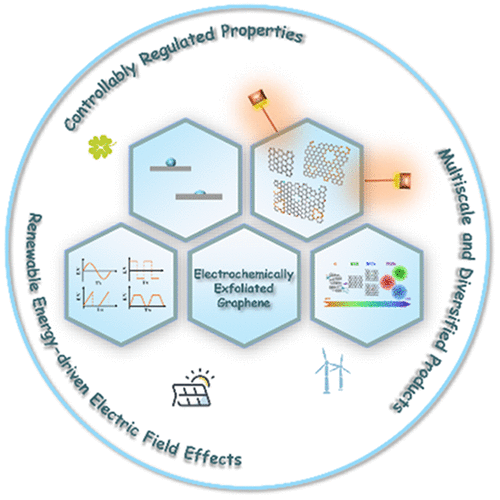当前位置:
X-MOL 学术
›
Acc. Mater. Res.
›
论文详情
Our official English website, www.x-mol.net, welcomes your
feedback! (Note: you will need to create a separate account there.)
Electric-Field-Triggered Graphene Production: From Fundamental Energy Applications to Perspectives
Accounts of Materials Research ( IF 14.0 ) Pub Date : 2022-01-04 , DOI: 10.1021/accountsmr.1c00211 Wenbin Li 1 , Chang Yu 1 , Xinyi Tan 1 , Zhao Wang 1 , Jieshan Qiu 1
Accounts of Materials Research ( IF 14.0 ) Pub Date : 2022-01-04 , DOI: 10.1021/accountsmr.1c00211 Wenbin Li 1 , Chang Yu 1 , Xinyi Tan 1 , Zhao Wang 1 , Jieshan Qiu 1
Affiliation

|
Two-dimensional sp2-hybridized graphene has been seriously considered and applied in various fields, such as materials science, energy storage/conversion, catalysis, and biomedicine, on account of its unique long-range-ordered and π-conjugated structure as well as excellent thermal and electric conductivity. At present, the adopted methods for graphene synthesis cover micromechanical exfoliation, epitaxial growth, chemical reduction of graphite oxide, chemical vapor deposition, and liquid-phase exfoliation. Nonetheless, a number of issues and challenges still existed in these employed methods in terms of sustainable and green energy chemistry and environmental friendliness. Electrochemical exfoliation is one of the most promising methods for the large-scale production of graphene by virtue of simple/eco-friendly operation and high-efficiency production. Depending on different exfoliation methods (anodic, cathodic, and dual-electrode) and electrochemical exfoliation conditions such as the reaction device, raw material, electrolyte, and power-supply mode, the exfoliated graphene features various and versatile characteristics. The relatively perfect graphene with intrinsic long-range π-conjugated character is accompanied by the fast capability of electron transfer. The defective graphene features the adjustable size and defect density and tunable amphipathicity. As a result, the corresponding graphene has been employed in energy storage/conversion, biology, and medicine fields. In this Account, we summarize the recent progress in the fundamentals of electrochemical exfoliation to produce the graphene and the derivative exfoliation method and their applications in energy-related fields, and the corresponding perspectives are also highlighted. First, we describe the fundamentals for different exfoliation methods and electric-field-induced effects that can help to guide us to prepare and produce graphene with various properties, covering the size, defect density, and surface chemistry. Subsequently, three electric-field-triggered methods (anodic, cathodic, and dual-electrode exfoliation) are discussed in detail. In particular, the effects of various electrolytes and power-supply modes on electrochemically exfoliated graphene (EEG) are systematically underlined in terms of the exfoliation principles and process, which are the significant factors affecting the structure and properties of EEG and the efficiency of intercalation and exfoliation. In addition, the recent progress in multilevel applications of EEG in energy storage/conversion fields such as supercapacitors, secondary batteries, the oxygen evolution reaction, the hydrogen evolution reaction, the carbon dioxide reduction reaction, and so forth is also summarized. Finally, the expectations and future research directions for the EEG in terms of controllably technological parameters and conditions, precise monitoring and in-depth comprehension of the exfoliation processes, multiscale and diverse products (carbon quantum dots, graphene quantum dots, and single-atom catalysts), and large-scale preparation and application are discussed, which hope to provide significant guidance for future research.
中文翻译:

电场触发的石墨烯生产:从基础能源应用到展望
二维 sp 2-杂化石墨烯以其独特的长程有序和π共轭结构以及优异的热电学特性,在材料科学、储能/转换、催化、生物医学等各个领域得到了认真的考虑和应用。电导率。目前,石墨烯的合成方法主要有微机械剥离法、外延生长法、氧化石墨化学还原法、化学气相沉积法和液相剥离法。尽管如此,这些采用的方法在可持续和绿色能源化学和环境友好性方面仍然存在许多问题和挑战。电化学剥离具有操作简单/环保、生产效率高等优点,是大规模生产石墨烯的最有前景的方法之一。根据不同的剥离方法(阳极、阴极和双电极)和电化学剥离条件(如反应装置、原材料、电解质和供电方式),剥离后的石墨烯具有多种特性。相对完美的石墨烯具有固有的长程 π 共轭特性,伴随着快速的电子转移能力。有缺陷的石墨烯具有可调节的尺寸和缺陷密度以及可调节的两亲性。因此,相应的石墨烯已被用于能量存储/转换、生物学和医学领域。在这个帐户中,我们总结了电化学剥离生产石墨烯的基本原理和衍生物剥离方法及其在能源相关领域的应用的最新进展,并且相应的观点也被突出显示。首先,我们描述了不同剥离方法和电场诱导效应的基本原理,它们可以帮助指导我们制备和生产具有各种特性的石墨烯,包括尺寸、缺陷密度和表面化学。随后,详细讨论了三种电场触发方法(阳极、阴极和双电极剥离)。特别是,从剥离原理和过程方面系统地强调了各种电解质和供电模式对电化学剥离石墨烯(EEG)的影响,这是影响EEG结构和性能以及插层效率的重要因素。去角质。此外,综述了脑电图在超级电容器、二次电池、析氧反应、析氢反应、二氧化碳还原反应等储能/转换领域的多层次应用的最新进展。最后,对脑电图在技术参数和条件可控、对剥离过程的精确监测和深入理解、多尺度多样化产品(碳量子点、石墨烯量子点和单原子催化剂)等方面的期望和未来研究方向),并讨论了大规模制备和应用,希望为今后的研究提供重要的指导。还总结了二氧化碳还原反应等。最后,对脑电图在技术参数和条件可控、对剥离过程的精确监测和深入理解、多尺度多样化产品(碳量子点、石墨烯量子点和单原子催化剂)等方面的期望和未来研究方向),并讨论了大规模制备和应用,希望为今后的研究提供重要的指导。还总结了二氧化碳还原反应等。最后,对脑电图在技术参数和条件可控、对剥离过程的精确监测和深入理解、多尺度多样化产品(碳量子点、石墨烯量子点和单原子催化剂)等方面的期望和未来研究方向),并讨论了大规模制备和应用,希望为今后的研究提供重要的指导。
更新日期:2022-01-04
中文翻译:

电场触发的石墨烯生产:从基础能源应用到展望
二维 sp 2-杂化石墨烯以其独特的长程有序和π共轭结构以及优异的热电学特性,在材料科学、储能/转换、催化、生物医学等各个领域得到了认真的考虑和应用。电导率。目前,石墨烯的合成方法主要有微机械剥离法、外延生长法、氧化石墨化学还原法、化学气相沉积法和液相剥离法。尽管如此,这些采用的方法在可持续和绿色能源化学和环境友好性方面仍然存在许多问题和挑战。电化学剥离具有操作简单/环保、生产效率高等优点,是大规模生产石墨烯的最有前景的方法之一。根据不同的剥离方法(阳极、阴极和双电极)和电化学剥离条件(如反应装置、原材料、电解质和供电方式),剥离后的石墨烯具有多种特性。相对完美的石墨烯具有固有的长程 π 共轭特性,伴随着快速的电子转移能力。有缺陷的石墨烯具有可调节的尺寸和缺陷密度以及可调节的两亲性。因此,相应的石墨烯已被用于能量存储/转换、生物学和医学领域。在这个帐户中,我们总结了电化学剥离生产石墨烯的基本原理和衍生物剥离方法及其在能源相关领域的应用的最新进展,并且相应的观点也被突出显示。首先,我们描述了不同剥离方法和电场诱导效应的基本原理,它们可以帮助指导我们制备和生产具有各种特性的石墨烯,包括尺寸、缺陷密度和表面化学。随后,详细讨论了三种电场触发方法(阳极、阴极和双电极剥离)。特别是,从剥离原理和过程方面系统地强调了各种电解质和供电模式对电化学剥离石墨烯(EEG)的影响,这是影响EEG结构和性能以及插层效率的重要因素。去角质。此外,综述了脑电图在超级电容器、二次电池、析氧反应、析氢反应、二氧化碳还原反应等储能/转换领域的多层次应用的最新进展。最后,对脑电图在技术参数和条件可控、对剥离过程的精确监测和深入理解、多尺度多样化产品(碳量子点、石墨烯量子点和单原子催化剂)等方面的期望和未来研究方向),并讨论了大规模制备和应用,希望为今后的研究提供重要的指导。还总结了二氧化碳还原反应等。最后,对脑电图在技术参数和条件可控、对剥离过程的精确监测和深入理解、多尺度多样化产品(碳量子点、石墨烯量子点和单原子催化剂)等方面的期望和未来研究方向),并讨论了大规模制备和应用,希望为今后的研究提供重要的指导。还总结了二氧化碳还原反应等。最后,对脑电图在技术参数和条件可控、对剥离过程的精确监测和深入理解、多尺度多样化产品(碳量子点、石墨烯量子点和单原子催化剂)等方面的期望和未来研究方向),并讨论了大规模制备和应用,希望为今后的研究提供重要的指导。











































 京公网安备 11010802027423号
京公网安备 11010802027423号